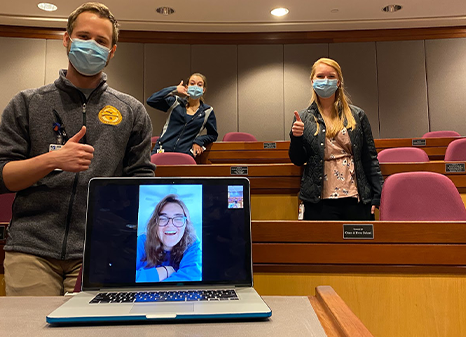
From left, SOM students Calvin Schaffer, Elya Reznichenko, Olivia Sears and Emma Cammann (on computer screen) prepare to teach clinic staff how to use telehealth services. |
Medical clinics across the nation are making swift adjustments due to the widespread novel coronavirus. Abiding by social distancing regulations to help flatten the curve, many physicians are transitioning to remote consultation.
This is where telehealth comes into play, and there are now dozens of clinics in Central Massachusetts offering the video conferencing option for patients, thanks to recent training from medical students at UMass Medical School.
“Roughly 80 student volunteers trained upwards of 850 people in about 65 clinics,” said Calvin Schaffer, first-year School of Medicine student. He is a member of the COVID-19 student task force, which executes projects to help physicians and hospitals in the Worcester area.
Telehealth allows patients and providers to conduct an appointment through live video conferencing. Users can log on with their smartphone, laptop or any electronic device. It’s an accessible form of health care that makes services more readily available and convenient, especially in a time in which face-to-face interactions are limited.
“The administrators were trained to walk a patient through downloading the AW Touchpoint app as well as how to use it, including setting up appointments with patients,” explained Elya Reznichenko, a second-year SOM student on the task force. “In addition, the nurses, doctors, nurse practitioners and physicians’ aides were taught how to initiate a call, invite multiple participants and utilize interpreters.”
Mark Manning, DO, associate professor of obstetrics & gynecology, served as an advisor to the student team. He noted that for people who have a telehealth appointment coming up, it’s important to remember a few things to make the process swift and effective.
“Have a full charge on your device; check internet speed; be in a well-lit, private place; and prevent any distractions,” Dr. Manning said.
Patrick Lowe, MD/PhD’20, spearheaded the UMMS training initiative. When he and his classmates graduated early and went directly into medical practice, the student task force stepped in to take over the training and recruited dozens of student volunteers.
“There were a lot of moving parts, and so many students dropped everything to make sure providers are well equipped,” said Emma Cammann, first-year SOM student and task force member.
“It took a lot of troubleshooting, brainstorming and versatility,” Schaffer added. “We were coordinating not only with our volunteers, but also with providers who are on chaotic schedules because of the crisis. We adjusted to best suit their needs.”
Manning said the initiative benefited students and providers.
“It’s a phenomenal educational experience for them to get exposed to how things really are,” he said.